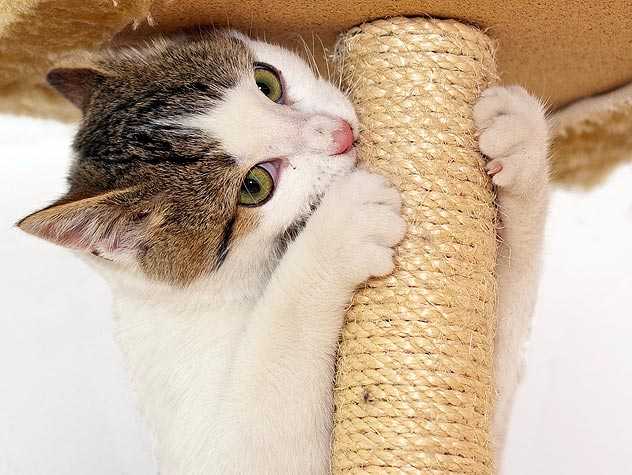How to Choose a Scratching Post for Your Cat

The list of supplies one needs when adopting a new cat or kitten can be staggering. Food, litter, toys, bed, scratching post, nail clippers, grooming brush… it's overwhelming! Just shopping for a scratching post, for example, means confronting dozens of sizes, shapes, and materials. When choosing this important accessory, learning to think like a cat can make things a little easier.
A scratching post is essential for any healthy, well-adjusted cat. Cats must have an outlet for their urge to scratch, so providing a post for that purpose can save your furniture, drapery and carpeting from destruction. Cats also use their scratching post for stretching and exercise, so obtaining a suitable post is vital to a cat's health and well-being.
All cats have claws on their front and rear paws. The rear ones are primarily for itching and for climbing, while front claws help a cat catch and hold on to prey. Both front and rear claws can also be used as defense if necessary.
Like human fingernails, cat claws continue to grow throughout a cat's life and need regular attention. Most cats take care of this themselves, by using their teeth to pull at their rear claw sheaths, revealing the sharp new claws underneath. For their front claws, it's easier to hook their claws in some material and pull downward, pulling off the old sheaths to expose the new claws.
Outdoor cats typically use tree stumps or wooden fenceposts to sharpen their front claws. If a cat has spent any time outside he may enjoy a scratching post of wood to remind him of the great outdoors. Some enterprising cat lovers bring firewood or small stumps indoors for their cat's pleasure, while others purchase scratching posts constructed of natural logs.
Another material of choice is corrugated cardboard. Economical cardboard posts are easy to replace and appeal to many cats. Usually they lie flat on the floor and may come with a toy attached to entice kitty to scratch at them. Since many cats enjoy cardboard posts and they're often quite inexpensive, first-time cat owners often start with this option before graduating to more elaborate and pricey cat furniture.
A post covered with rough sisal rope is another popular option. The sisal accomplishes the same purpose as tree bark outside - it catches the front claws so the cat can pull downward and release the sheath to expose the new claw underneath. Sisal posts do cost a bit more than disposable cardboard ones, but they're durable and last for years before they need replacement. Many cats enjoy using posts covered in sisal.
Some scratching posts sold in stores are covered with carpeting. While the carpet accomplishes the same purpose as sisal, it often resembles the carpeting found on staircases and floors in homes. Some cats may not make a distinction between the carpet on their scratching post and that in the rest of the house. These cats often pull at carpeted stairs and floors, and usually benefit from a switch to a post made from a different material.
To most cats, the sturdiness and stability of a scratching post matters even more than the material of construction. Cats put a lot of energy into sharpening their claws, and they can't scratch with gusto if the post won't stay upright. A wood or sisal post must be attached to a sturdy base that won't wobble when the cat's scratching. A wobbly post may also be nailed onto a larger base for more stability. Cardboard posts that lie flat on the floor should be large enough for the cat to stand on them and scratch at the same time.
Another factor to consider is the height of the post. Cats reach upward and pull down against the post, so a cat's post should be at least half again as tall as he is to allow him to stretch. The taller and more sturdy the post, the greater the chance of a cat preferring the post to a couch or armchair.
Lastly, placement of the scratching post in a home plays a role in a cat's acceptance of the post. Outdoor cats scratch prominent markers in their territory, leaving both scent and visual warnings for other feline intruders. For the same reason, many cats who scratch furniture choose a prominent chair arm or table leg, so anyone entering the room or home will know immediately whose territory they're in. Placing a scratching post in a prominent location in the most used room in the house, even directly in front of the piece of furniture the cat has shown a preference for, will often encourage the cat to scratch the post to mark his territory.
Whether cardboard, wood, or sisal, vertical or horizontal, simple or elaborate, an effective scratching post exists to satisfy every demanding cat and owner. Choosing a post to please your cat can be an adventure, with vigorous scratching and purring the reward.